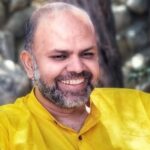Article by Dr. Nandini Murali, a participant of Mahabharata Exploration Online program. Dr. Nandini is a Communication Professional, Author and a Researcher in Indic Studies.
As a seven-year-old, I sat under the mango tree in our home with my grandfather, as he helped me read aloud from C. Rajagopalachari’s retelling of the Ramayana and Mahabharata. A daily morning ritual for several years, it was my introduction to our Itihasa-Purana tradition. While both epics fascinated me, the Mahabharata had me spellbound. Interestingly, several decades later, I re-engaged with the Mahabharata in a dramatically different way.
Recently, I participated in the Mahabharata Exploration, a ten-week online offering, elegantly co-facilitated by Anita Balasubramanian, Kavitha Elango and Hariprasad Varma—yoga therapists, and members of Ritambhara Acharya Sangha, a group of seeker-teachers affiliated to Ritambhara Ashram. Nestled amidst sylvan surroundings in the Nilgiris, Ritambhara is a community of sacred activists from diverse backgrounds who explore alternate ways of being and living as part of a quest to live a life of meaning and purpose.
A group of 24 seekers, each one so different, yet so similar in our quest for inner transformation, met every Thursday at 8 pm for an hour and half for ten weeks. The virtual space gradually transformed into a subliminal sacred space as we began to explore the Mahabharata as a mirror to understand ourselves and our inner reality. What can the Mahabharata offer to look at ourselves; to discover hidden parts of ourselves that have either been banished, exiled or simply buried under the rubble of mindless living on autopilot?
True to its promise, even our first session began with three apparently simple but challenging questions that elude knee jerk responses: Who am !? Where am I? Why am I here?
“Our approach at Ritambhara, based on the tradition and teachings of Yogacharya Krishnamacharya and Shri T.K.V. Desikachar explores the convergence of Itihasa-Purana tradition and inner work (antaranga sadhana) through dialogue and contemplation as described in the Yoga sutras. We use the stories in the Mahabharata as a mirror to engage in dialogue and contemplation to do dharana on the mind. The stories evoke us; cause a churning in the psyche (manthan). In this intense process, we experience the story, touch the rasa (essence) and discover the inner deeply self-aware space (shantam) from where we can view our inner drama,” explained Anita, Kavitha and Hari.
Throughout the sessions, the focus was on evocation or feelings, memories or ideas the story evoked in our conscious minds. As we engaged with several episodes from the epic, clubbed together as the Pandava archetypes—Yudhishthira, Bhima, Arjuna, Karna, Nakula, Sahadeva and Draupadi stories—we began to engage with them not intellectually but experientially. We were sent a story every week before the class. For instance, we began with the Sabha at Jayanta where Shakuni and Duryodhana plot to entice the Pandavas to a diabolical game of dice. Hence it demanded that we engage with the story not from an intellectual or cognitive space.
“Therefore, what is important is not the story or its interpretation or analysis as such. But the meaning one makes of it, because this meaning reflects me, who I am,” the facilitators said as they laid out a tentative road map for our inner exploration.
It was liberating to be freed from the tyranny of the rational, logical brain. Instead we were now being challenged to respond viscerally, tuning in to our intuitive intelligence and an embodied way of knowing in relating to the stories. For instance, I read the Jayanta story not once but several times. It required tremendous focus and a tuning in both while reading the story and after. Often, the evocation would not be instantaneous. Journaling or writing in a free associative manner about what I had just read helped me connect deep within. Often, what was evoked could be a word, a thought, a symbol or image. The stage was set for each of us in the group to explore individually and collectively how we discover, connect and express archetypal energy patterns to heal and transform ourselves.
We were also encouraged to allow the characters to speak to us in multiple ways without stereotyping, reducing or pigeonholing them. I felt humbled to glimpse in me the jealousy and envy that Duryodhana feels at another’s success. It was a shadow moment.
Shadows, in the human psyche, are qualities in ourselves that we have disowned, rejected, exiled from our psyche and refuse to acknowledge them because they are regarded as negative or undesirable qualities. Duryodhana was no longer just a character; an antihero or villain. He existed within me as an archetype or energy pattern.
Confronting my inner Duryodhana was an ‘aha’ moment for me. Now that I had just acknowledged the Duryodhana archetype within me, could I give myself permission to look at the pattern with compassion and curiosity and not harsh judgementality? Could I permit myself the time and space to integrate this pattern lovingly into my consciousness without hurrying to hide it, fix it, fade it or get rid of it?
“Itihasa and Puranas help us map our inner world. They reflect the yogic ideals of continuous investment in one’s competencies, inner well-being and holistic health through stories that illustrate how the human mind perceives and responds. The Mahabharata is a yoga text that is a repository of archetypes and dilemmas in human contexts.
These are intensely human stories that although written more than 5000 years back, is still new. The root of the word Puranam (pura api navam) itself suggests this old-yet-newness. The word Itihasa suggests ‘Wow! Is that the way it was?’ and creates a sense of wonder in the reader or listener. It’s the way we read the Puranas that makes it nascent or new,” explains Raghu Ananthanarayanan, co-founder Ritambhara.
Raghu has delved deeply into Bharatiya Knowledge Traditions such as Yoga, theatre, dance, art and contemplative conversations to evolve a one-week residential experiential offering known as the Mahabharata Immersion. The Mahabharata Exploration is an abridged online version of the residential programme.
According to Raghu, contrary to popular perception, the Puranas are not designed to enable readers or listeners to emulate the characters. Instead they have the potential to excite the reader or listener that leads to identification (Can I be like this?), spur an immersion in the character, which can then lead to self-mastery.
Human life is an interplay of archetypes that are expressed either appropriately or inappropriately. How do I engage with the Mahabharata to get in touch with my archetypal energies?
“I contradict myself. I am large. I contain multitudes,” said Walt Whitman, the mystical poet. As I engaged with the characters, I discovered propensities or tendencies that reflected the heroic and shadow (contradictory) sides of each character, also embedded in me, although some were more developed than others. What meaning did the archetypes embody in my life? What in my life reflected these archetypes? How did the archetypes pan out in my life?
Every archetype had embedded within its opposite. For instance, when I looked at Yudhishthira, I resonated with his ability to respect and uphold traditions and rules. However, like him, I too get trapped in self-righteousness and rigidity. Similarly, Bhima’s passion and his connect with challenges resonated with me, as his impulsivity and absence of forethought. Arjuna’s ability to integrate the masculine and feminine aspects of the psyche was delightful, as his authenticity and courage in asking profound existential question, “In doing what I am doing, what am I really doing?”
Like Nakula, I am giving and compassionate, but also fail to replenish myself. Like Sahadeva, I enjoy engaging with challenges and knowledge at an abstract level, but sometimes also get trapped in intellectualism and lose my ability to be pragmatic. Draupadi’s resilience, her sharangati (absence of resistance to the Divine) and ability to confront people and situations is also in me, but like her, sometimes I tend to forget that no action is consequence-free. Like Karna, I too have admirable skills, but like him, for several decades I was entrapped in victimhood and held on to a disempowering notion of vulnerability.
Each of these archetypal aspects plays out relentlessly in our lives. Some of us may have an excessive engagement (ati yogam) with one of these propensities; insufficient (hina yogam) or absence of engagement (viyogam). Awareness of these imbalances is a first step towards integration of archetypes that results in inner harmony.
Each character was a mirror that helped me see myself clearly, once the layers of dust and debris began to cleave even ever so slightly. The archetypal energies embodied by each of these characters is universal and gender inclusive. Thus, each of us contains the polarities of the daivic (heroic) energy (represented by the Pandavas) and the asuric (shadow) energy (represented by the Kauravas) as also the daivic and asuric aspect of each Pandava character. Can I step back and look at all parts of myself with attentiveness, curiosity and compassion and hold them tentatively? Can I step back and look at the narrative I am creating about myself and the world and ask myself, “In doing what I am doing, what am I really doing?”
The exploration enabled me to realise that each of us is equally capable of behaving in a heroic or diabolical manner. If I don’t behave like the Kauravas in a situation, it because of viveka (discrimination) that leads me to make conscious responsible choices—choices that make all the difference if my life is lived meaningfully and purposefully—either in Kurukshetra (battlefield) or dharmakshetra (a sacred space). Each of us is a work in progress… on a sacred quest of becoming the best versions of ourselves… imbued with the fragrance of rasatmika (full of joy) and excellence.
Note: This article was originally published in the Hindu Post on 30 July 2020. Link to original post: Inner Transformation Through the Mahabharata


 Anoop is a student of Yoga, an entrepreneur, a coach and a father of two young boys. He has led successful leadership stints in both the corporate and non-for-profit sectors. On encountering the country’s water/farmer crises at close quarters, he decided to pause and examine the impact various ‘isms’ – capitalism, colonialism, etc., were having on us as individuals, families, the society and the environment at large. This quest led him to formally engage with traditional Indic knowledge systems while also learning from the latest advances in science – about our physical and mental wellbeing, importance of body and mind work in healing trauma and the urgent need for a conscious rebuilding of family / work / social structures if we have to thrive individually and collectively. Insights, frameworks and processes gleaned from these on-going studies, an anchorage in his own personal practice and his wide-ranging experiences is what Anoop brings to facilitation/coaching spaces in Ritambhara and his various professional engagements.
Anoop is a student of Yoga, an entrepreneur, a coach and a father of two young boys. He has led successful leadership stints in both the corporate and non-for-profit sectors. On encountering the country’s water/farmer crises at close quarters, he decided to pause and examine the impact various ‘isms’ – capitalism, colonialism, etc., were having on us as individuals, families, the society and the environment at large. This quest led him to formally engage with traditional Indic knowledge systems while also learning from the latest advances in science – about our physical and mental wellbeing, importance of body and mind work in healing trauma and the urgent need for a conscious rebuilding of family / work / social structures if we have to thrive individually and collectively. Insights, frameworks and processes gleaned from these on-going studies, an anchorage in his own personal practice and his wide-ranging experiences is what Anoop brings to facilitation/coaching spaces in Ritambhara and his various professional engagements.
 Priya is a Yoga therapist in the Krishnamacharya tradition. She adapts Reiki & energy work, Vedic chanting, life coaching & Ayurvedic practices in her healing spaces. She is committed to nurturing collectives that have the praxis of Yoga at their heart.
Priya is a Yoga therapist in the Krishnamacharya tradition. She adapts Reiki & energy work, Vedic chanting, life coaching & Ayurvedic practices in her healing spaces. She is committed to nurturing collectives that have the praxis of Yoga at their heart. Anisha has been on an exploration to understand herself through yoga for the last 15years which led her to teaching yoga, yoga therapy and inner work through yoga.
Anisha has been on an exploration to understand herself through yoga for the last 15years which led her to teaching yoga, yoga therapy and inner work through yoga. Apoorva chanced upon Yoga in her early 20s. A spark was lit within and there was no turning back. Her exploration led her to the Krishnamacharya tradition more than a decade ago. Curious about human behaviour and what drives it, she was thrilled when her search ended (and also began) when she first came upon the Yoga Sutra, which illuminated a path towards answering many questions that had been held for a long time.
Apoorva chanced upon Yoga in her early 20s. A spark was lit within and there was no turning back. Her exploration led her to the Krishnamacharya tradition more than a decade ago. Curious about human behaviour and what drives it, she was thrilled when her search ended (and also began) when she first came upon the Yoga Sutra, which illuminated a path towards answering many questions that had been held for a long time. Anita is a yoga teacher and therapist in the tradition of Sri.T.Krishnamacarya and Sri T.K.V. Desikachar, a Reiki practitioner and a Life Coach. She is also the founder of Vishoka, a center for learning Indic and energy-based frameworks for living and healing. Her deep concern for human suffering and the problems of unsustainable living kept her on the path of seeking an integrated approach to looking at life, living, learning and healing.
Anita is a yoga teacher and therapist in the tradition of Sri.T.Krishnamacarya and Sri T.K.V. Desikachar, a Reiki practitioner and a Life Coach. She is also the founder of Vishoka, a center for learning Indic and energy-based frameworks for living and healing. Her deep concern for human suffering and the problems of unsustainable living kept her on the path of seeking an integrated approach to looking at life, living, learning and healing. Ankit is a seeker in the wisdom traditions of India. The core of his work includes creating dialogic spaces where people can look within and see the connection between their inner and outer lives. Inspired by the likes of Gandhi, Aurobindo, Vivekananda and Guru Gobind his experiments in service took him back to his roots in Punjab where he is creating a community-led model of higher education which is open, inclusive and accessible for all. Ritambhara for him is a space for engaging in a community which is committed to a DHramic life. He anchors his work of learning and leadership in the Antaranga Yoga Sadhana and the humanistic wisdom of Mahabharata.
Ankit is a seeker in the wisdom traditions of India. The core of his work includes creating dialogic spaces where people can look within and see the connection between their inner and outer lives. Inspired by the likes of Gandhi, Aurobindo, Vivekananda and Guru Gobind his experiments in service took him back to his roots in Punjab where he is creating a community-led model of higher education which is open, inclusive and accessible for all. Ritambhara for him is a space for engaging in a community which is committed to a DHramic life. He anchors his work of learning and leadership in the Antaranga Yoga Sadhana and the humanistic wisdom of Mahabharata.
I loved this description of the experience of the course – very insightful – and a good summary of the approach.